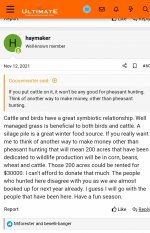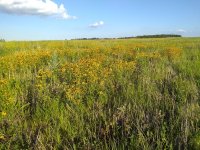Weimdogman
Well-known member
There is a great symbiotic relationship between pheasants and cattle. A factor in dwindling bird numbers is lack of cattle/livestock on every farm as was often the case in the past. Cattle kept Stubblefield open for birds to forage. Eliminated corn is scavenged by the birds also. Feedlots which take the place of those small herds do nothing for habitat and many would say hurt it. A lesser effect is utilized poor hayground slough grass dry enough to hay can be fed as it is ground and mixed with other feed-nutrients-vitamins-medicine. Another thing is no Cattle no fence rows of nesting cover on the edge of grain fields.
Here in S.D. my buddies and I look for areas with the 3 C's Corn Cattle Cattails. Find those and there will be birds
Here in S.D. my buddies and I look for areas with the 3 C's Corn Cattle Cattails. Find those and there will be birds



